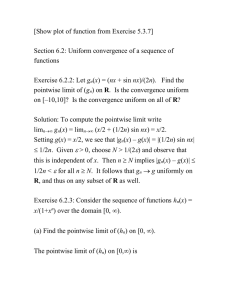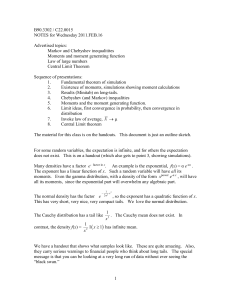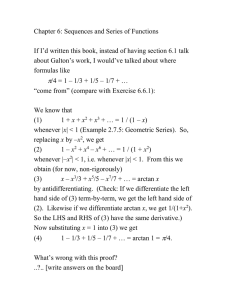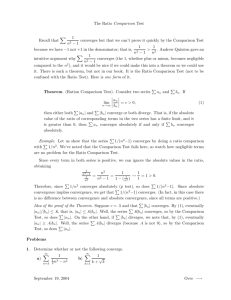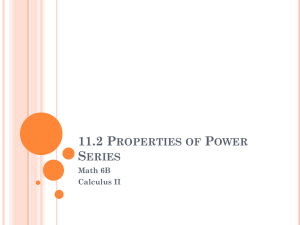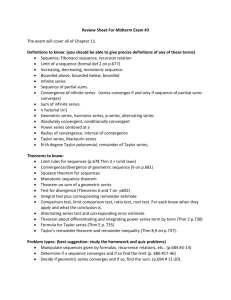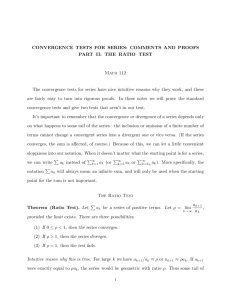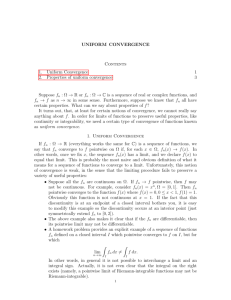Math 341 Lecture #28 §6.2: Uniform Convergence, Part II Example
advertisement
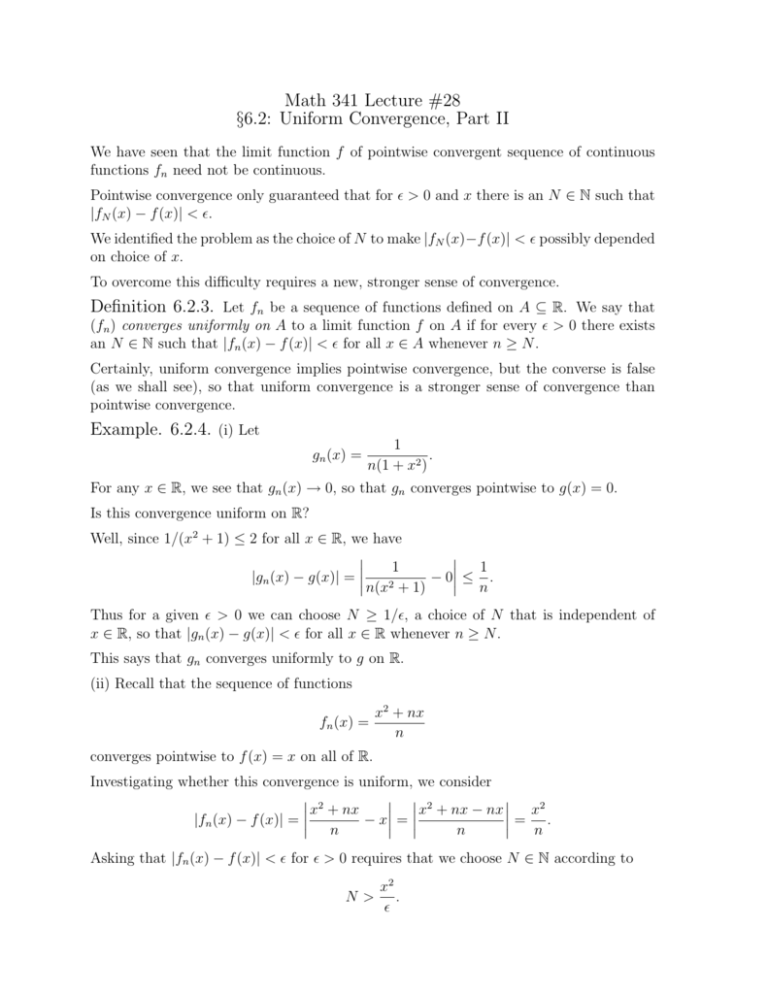
Math 341 Lecture #28 §6.2: Uniform Convergence, Part II We have seen that the limit function f of pointwise convergent sequence of continuous functions fn need not be continuous. Pointwise convergence only guaranteed that for > 0 and x there is an N ∈ N such that |fN (x) − f (x)| < . We identified the problem as the choice of N to make |fN (x)−f (x)| < possibly depended on choice of x. To overcome this difficulty requires a new, stronger sense of convergence. Definition 6.2.3. Let fn be a sequence of functions defined on A ⊆ R. We say that (fn ) converges uniformly on A to a limit function f on A if for every > 0 there exists an N ∈ N such that |fn (x) − f (x)| < for all x ∈ A whenever n ≥ N . Certainly, uniform convergence implies pointwise convergence, but the converse is false (as we shall see), so that uniform convergence is a stronger sense of convergence than pointwise convergence. Example. 6.2.4. (i) Let gn (x) = 1 . n(1 + x2 ) For any x ∈ R, we see that gn (x) → 0, so that gn converges pointwise to g(x) = 0. Is this convergence uniform on R? Well, since 1/(x2 + 1) ≤ 2 for all x ∈ R, we have 1 1 ≤ . |gn (x) − g(x)| = − 0 n n(x2 + 1) Thus for a given > 0 we can choose N ≥ 1/, a choice of N that is independent of x ∈ R, so that |gn (x) − g(x)| < for all x ∈ R whenever n ≥ N . This says that gn converges uniformly to g on R. (ii) Recall that the sequence of functions fn (x) = x2 + nx n converges pointwise to f (x) = x on all of R. Investigating whether this convergence is uniform, we consider 2 2 x + nx x + nx − nx x2 = . |fn (x) − f (x)| = − x = n n n Asking that |fn (x) − f (x)| < for > 0 requires that we choose N ∈ N according to N> x2 . This says that we cannot choose one value of N that works for all x ∈ R, and so the pointwise convergence of fn to f is not uniform on R. If instead, we restrict the domain of fn to a bounded subset [−b, b], then we can get uniform convergence of fn to f by choosing N> b2 . That is we have for all x ∈ [−b, b] that |fn (x) − f (x)| = b2 b2 x2 ≤ ≤ < n n N for all n ≥ N . For b = 1, what does uniform convergence of fn to f on [−1, 1] means geometrically? For = 1/2 and b = 1 we have that N = 3 > 12 /(1/2) = 2, and we get |fn (x) − f (x)| < 1/2 or f (x) − 1/2 < fn (x) < f (x) + 1/2 for all x ∈ [−1, 1] and all n ≥ 3. Here are the graphs of f (x) = x, f (x) + 1/2, f (x) − 1/2, and fn (x) for n = 3, 4, 5. What do you notice about the graphs of fn (x) for n = 3, 4, 5? Each lies within the = 1/2 “tube” about f (x) on [−1, 1]. This is what uniform convergence means geometrically. Recall the Cauchy Criterion for the convergence of a sequence of real numbers did not require a “guess” for the limit. We have a similar criterion for uniform convergence. Theorem 6.2.5 (Cauchy Criterion for Uniform Convergence). A sequence of functions (fn ) defined on A ⊆ R converges uniformly on A if and only if for every > 0 there exists an N ∈ N such that |fn (x) − fm (x)| < for all n, m ≥ N and all x ∈ A. Proof. Suppose that fn converges uniformly to f on A. Then for > 0 there exists N ∈ N such that |fn (x) − f (x)| < /2 for all n ≥ N and all x ∈ A. Thus for n, m ≥ N and any x ∈ A we have |fn (x) − fm (x)| = |fn (x) − f (x) + f (x) − fm (x)| ≤ |fn (x) − f (x)| + |fm (x) − f (x)| < + 2 2 = . Now suppose that for all > 0 there exists N ∈ N such that |fn (x) − fm (x)| < for all n, m ≥ N and all x ∈ A. Then for each x ∈ A, the sequence (fn (x)) is Cauchy sequence of real numbers, and therefore it converges to a real number, call it f (x). We have found a function f : A → R which is the pointwise limit of fn . By the Algebraic Limit and Order Limit Theorems we have for all n ≥ N and all x ∈ A that |fn (x) − f (x)| = lim |fn (x) − fm (x)| ≤ m→∞ which says that fn converges uniformly to f on A. The stronger assumption of uniform convergence is enough to guarantee that the limit function of a sequence of continuous functions is continuous. Theorem 6.2.6. Let (fn ) be a sequence of functions defined on A ⊆ R that converges uniformly on A to f . If each fn is continuous at c ∈ A, then f is continuous at c too. Proof. Fix c ∈ A, and for > 0 choose N ∈ N such that for all x ∈ A we have |fN (x) − f (x)| < . 3 By the continuity of fN at c there exists δ > 0 such that whenever |x − c| < δ we have |fN (x) − fN (c)| < . 3 Thus |f (x) − f (c)| ≤ |f (x) − fN (x)| + |fN (x) − fN (c)| + |fN (c) − f (c)| < + + = 3 3 3 whenever |x − c| < δ, and so f is continuous at c.

